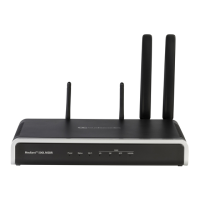User's Manual 256 Document #: LTRT-10466
Mediant 500L MSBR
18.6 Configuring Call Setup Rules
The Call Setup Rules table lets you configure up to 40 Call Setup rules. Call Setup rules
define various sequences that are run upon the receipt of an incoming call (dialog) at call
setup, before the device routes the call to its destination. Call Setup rules can be
configured for any call direction (SBC, Tel-to-IP, or IP-to-Tel). Call Setup rules provides you
with full flexibility in implementing simple or complex script-like rules that can be used for
Lightweight Directory Access Protocol (LDAP) based routing as well as other advanced
routing logic requirements such as manipulation. These Call Setup rules are assigned to
routing rules.
Below is a summary of functions for which you can employ Call Setup rules:
LDAP query rules: LDAP is used by the device to query Microsoft’s Active Directory
(AD) server for specific user details for routing, for example, office extension number,
mobile number, private number, OCS (Lync) address, and display name. Call Setup
rules provides full flexibility in AD-lookup configuration to suite just about any customer
deployment requirement:
• Routing based on query results.
• Queries based on any AD attribute.
• Queries based on any attribute value (alphanumeric), including the use of the
asterisk (*) wildcard as well as the source number, destination number, redirect
number, and SBC SIP messages. For example, the following Call Setup rule
queries the attribute "proxyAddresses" for the record value "WOW:" followed by
source number: "proxyAddresses=WOW:12345*"
• Conditional LDAP queries, for example, where the query is based on two
attributes (&(telephoneNumber=4064)(company=ABC).
• Conditions for checking LDAP query results.
• Manipulation of call parameters such as source number, destination number, and
redirect number and SBC SIP messages, while using LDAP query results.
• Multiple LDAP queries.
Manipulation (similar to the Message Manipulations table) of call parameters (such as
source number, destination number, and redirect number) and SBC SIP messages.
Conditions for routing, for example, if the source number equals a specific value, then
use the call routing rule.
You configure Call Setup rules with a Set ID, similar to the Message Manipulations table,
where multiple rules can be associated with the same Set ID. This lets you perform multiple
Call Setup rules on the same call setup dialog.
To use your Call Setup rule(s), you need to assign the Call Setup Rules Set ID to the
relevant routing rule. This is done using the 'Call Setup Rules Set ID' field in the routing
table:
SBC IP-to-IP routing - see Configuring SBC IP-to-IP Routing Rules on page 564
Tel-to-IP routing rules - see Configuring Outbound IP Routing on page 405
IP-to-Tel routing rules - see Configuring Inbound IP Routing on page 414
If an incoming call matches the characteristics of a routing rule, the device first runs the
assigned Call Setup Rules Set ID. The device uses the routing rule to route the call,
depending on the result of the Call Setup Rules Set ID:
Rule's condition is met: The device performs the rule's action and then runs the next
rule in the Set ID until the last rule or until a rule with an Exit Action Type. If the Exit
rule is configured with a "True" Action Value, the device uses the current routing rule.
If the Exit rule is configured with a "False" Action Value, the device moves to the next
routing rule. If an Exit Action Type is not configured and the device has run all the
rules in the Set ID, the default Action Value of the Set ID is "True" (i.e., use the current
routing rule).

